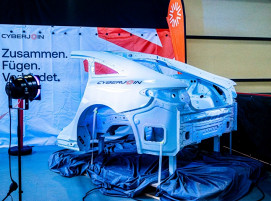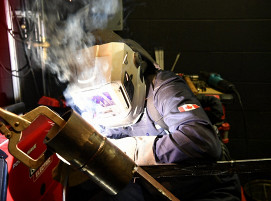
All the Control, None of the Fuss
To enable intuitive control over the variables that optimise TIG welding performance, ESAB has introduced the Rogue™ ET 230i AC/DC TIG and MMA welder, which features ESAB’s signature 5-in. colour TFT graphical interface. The Rogue ET 230i provides the types of controls welding professionals demand, including pulse AC and DC TIG, an adjustable AC output frequency, AC amplitude offset, a TIG sequencer, four AC waveshape options and an optional water-cooler and water-cooled TIG torch.
“The Rogue 230i defies expectations because it provides operators more control over heat input, distortion, penetration, puddle direction, bead appearance and weld quality without the typical complexities associated with setting TIG variables,” says Bartosz Kutarba, Global Director – Light Industrial Equipment, ESAB. “No other machine on the market can match Rogue’s combination of intuitive operation, range of control and affordability. It is an ideal machine for both experienced and newer welders.”
With Lift TIG and high frequency (HF) arc starting options, it enables users to weld steel, stainless steel, aluminium and other metals in a wide range of applications, including general fabrication, process industries, tube and pipe fabrication, repair and maintenance, and aerospace. For optimised arc starts, users enter the tungsten type and diameter and the machine will automatically set parameters.
The Rogue 230i ET AC/DC has a TIG welding amperage adjustable from 5 to 230A DC and 15 to 230A AC (maximum output of 230A at 30 % duty cycle) and a maximum MMA output of 180A at 30 % duty cycle for welding with electrodes up to 4 mm. It connects to 115/230V AC mains power and meets the EU’s Ecodesign Directives for energy efficiency.
Control for Aluminium
The Rogue ET 230i works well for welding aluminium because it provides four AC waveshape options: square wave for maximum arc stability and energy transfer, soft square for a softer arc and more fluid puddle, sinusoidal for a quieter and traditional arc, and triangle for reduced heat input on thinner material. To further tailor the wave form to the application, the machine also offers an amperage offset that is adjustable ± 50 amps in each half of the AC cycle.
“Offset control varies the electrode negative (EN) or electrode positive (EP) current by up to 50 amps without changing other variables,” says Remigiusz Synowiec – Global Product Manager, ESAB. “Users increase EN offset to direct more current into the weld and reduce current on the tungsten. More EN creates deeper penetration and a narrower weld bead with less visible cleaning, and it lets you weld at higher amperage without degrading the tungsten. Increasing EP values adds more cleaning action to remove surface oxides and creates a wider bead with less penetration, which may help with thinner material.”
The Rogue ET 230i also provides an AC frequency control adjustable from 50 to 150 Hz. Higher frequencies produce a narrower, more intense arc cone that helps direct the arc at the root of the joint in a fillet weld. Higher frequencies also narrow bead width and increase penetration and travel speeds. An AC wave balance control adjusts from 50 to 85 percent EN.
The Benefits of Pulsing
The Rogue ET 230i provides a pulsed TIG AC and DC outputs that are adjustable from 0.5 to 150 Hz (pulses per second). With pulsed TIG, the welding power source pulses the welding current between a high peak current and a low background current, with the background current set as a percentage of peak current. Stainless steel fabricators and those working with thin metals or other heat-sensitive applications use pulsed TIG to control heat input, narrow the weld bead profile and increase travel speed.
To make it faster and easier to adjust TIG variables, the Rogue ET 230i offers four “TIG Home View” options that graphically and numerically display key values. The view options are Basic (which shows weld mode, trigger control option and weld current), TIG Sequencer (gas pre- and post-flow, slope up and down, and start, main and end welding currents), Pulse TIG variables and AC Settings. Pushing the main control knob enables users to scroll through and adjust key values for advanced TIG control in a matter of seconds.
Rogue also offers four Trigger Modes: -2T, 4T, 4T2 (or dual-current mode) and spot welding. The 4T2 mode switches the value of the main current to a lower welding current with a quick tap of the torch trigger. A second tap returns the setting to the main current. This function helps when welding around corners or edges without stopping the weld. In addition, favorite settings can be stored with the jobs function and recalled in seconds using the torch trigger. “The controls on the new Rogue help less experienced operators focus on mastering their TIG welding craft without having to master a difficult machine, while experienced operators can fine tune the arc and boost productivity with advanced settings,” says Synowiec.
(Source: ESAB Press Release)






